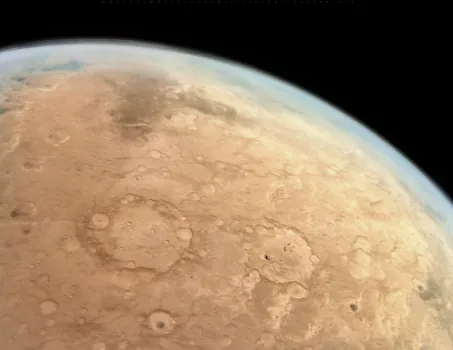
New NASA Study Sparks Hopes for Microbial Life in Hidden Martian Water Pools!
2024-10-27
Author: Mei
Exciting Revelation About Microbial Life on Mars
In an exciting revelation that could reshape our understanding of extraterrestrial life, a recent NASA study has ignited discussions around the potential for microbial life hiding beneath the frozen surface of Mars. For decades, scientists have been captivated by the possibility that life once thrived on the Red Planet, and this new research offers significant clues about where to look.
Subsurface Pools of Water
The study presents a bold proposition: that microbial organisms could survive in shallow pools of water located just below layers of ice on Mars. Utilizing advanced computer modeling, the research team, led by Aditya Khuller from NASA's Jet Propulsion Laboratory (JPL), suggests that these subsurface pools may have conditions conducive for photosynthesis. Remarkably, similar environments on Earth have been found to host thriving ecosystems of algae, fungi, and cyanobacteria.
Accessibility for Life Search
"If we're trying to find life anywhere in the universe today, Martian ice exposures are probably one of the most accessible places we should be looking,” Khuller asserts, highlighting the study's implications for future space exploration.
Characteristics of Martian Ice
Mars is uniquely characterized by its two types of ice: water ice and frozen carbon dioxide. This research specifically zeroes in on the vast deposits of water ice found on the Martian surface, believed to have formed during a series of ice ages. The ice traps dust particles, which can absorb sunlight more effectively than the surrounding ice. This phenomenon may create pockets of liquid water just beneath the surface—potential havens for life.
Challenges and Conditions for Liquid Water
Despite these promising findings, planetary scientists are still piecing together the challenges posed by Mars' thin atmosphere. Water ice on the surface risks sublimating, which complicates our understanding of whether it can actually melt and form the subsurface pools. Crucially, the team believes that the conditions beneath the surface can be quite different, potentially allowing for stable liquid water environments.
Cryoconite Holes and Similar Processes
But what makes these subsurface pools tick? Drawing parallels with Earth, researchers explain that dust can create cryoconite holes—tiny pockets of melted water formed when sunlight efficiently warms the ice around it. Khuller et al. propose that similar processes could occur on Mars, nurturing ecosystems deep under layers of ice while offering protection from harmful solar radiation that permeates the Martian atmosphere.
Foundation of Past Studies
Past studies have provided a solid foundation for this research. Notably, previous work by both Khuller and co-author Phil Christensen, a prominent figure from Arizona State University, demonstrated that liquid water could form in Martian snowpacks and identified erosive gullies forged by melting ice. These findings underscore the likelihood that photosynthesis could indeed occur beneath Mars' icy exterior.
Looking Ahead
Looking ahead, Khuller and his team aim to simulate Mars's dusty water ice conditions in laboratories on Earth, pinpointing where these life-sustaining shallow water pools may exist on the Martian surface. Successfully identifying such locations could pave the way for targeted missions, whether robotic or human-led, to seek out signs of life.
Published Findings
The study's findings were published in *Nature Communications Earth & Environment* on October 17, signaling an exciting chapter in the search for life beyond Earth.





 Brasil (PT)
Brasil (PT)
 Canada (EN)
Canada (EN)
 Chile (ES)
Chile (ES)
 España (ES)
España (ES)
 France (FR)
France (FR)
 Hong Kong (EN)
Hong Kong (EN)
 Italia (IT)
Italia (IT)
 日本 (JA)
日本 (JA)
 Magyarország (HU)
Magyarország (HU)
 Norge (NO)
Norge (NO)
 Polska (PL)
Polska (PL)
 Schweiz (DE)
Schweiz (DE)
 Singapore (EN)
Singapore (EN)
 Sverige (SV)
Sverige (SV)
 Suomi (FI)
Suomi (FI)
 Türkiye (TR)
Türkiye (TR)